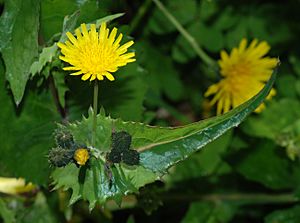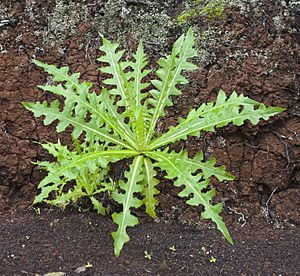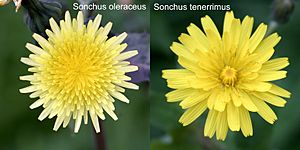Sow thistles facts for kids
Quick facts for kids Sow thistles |
|
|---|---|
 |
|
| Sonchus oleraceus | |
| Scientific classification |
|
| Kingdom: | Plantae |
| Clade: | Tracheophytes |
| Clade: | Angiosperms |
| Clade: | Eudicots |
| Clade: | Asterids |
| Order: | Asterales |
| Family: | Asteraceae |
| Subfamily: | Cichorioideae |
| Tribe: | Cichorieae |
| Subtribe: | Hyoseridinae |
| Genus: | Sonchus L. |
| Type species | |
| Sonchus oleraceus |
|
| Synonyms | |
|
|
Sonchus, often called sow thistles, are a type of flowering plant. They belong to the same plant family as sunflowers and dandelions, called Asteraceae. You might also hear them called "hare thistles" or "hare lettuces." Sow thistles can be annuals (live one year), biennials (live two years), or perennials (live many years). Some even grow into small woody plants, especially in the Canary Islands.
Contents
What are Sow Thistles?
The name Sonchus comes from an Ancient Greek word for these kinds of plants. Sow thistles have soft leaves that are a bit jagged. These leaves wrap around the plant's stem and often start as a cluster near the ground. If you cut the stem, a milky white liquid, called latex, comes out.
Their flowers are yellow and look like small dandelions. Each flower head is about half an inch to one inch wide. The fruits are small, dry, and contain a single seed. Sow thistles are very common plants found along roadsides. While they originally came from Eurasia and tropical Africa, they now grow almost everywhere in temperate parts of the world.
Plant Size and Milky Sap
Mature sow thistle stems can grow from about 30 centimeters (1 foot) to 2 meters (6 feet) tall. Their color can be green or even purple in older plants. When any part of the plant is cut or damaged, it oozes a milky sap. This is why they are called "sow thistles." People used to feed them to sows (female pigs) that were nursing their babies. They believed it would help the sows produce more milk. In some places, sow thistles are also called "milk thistles," but true milk thistles are a different kind of plant.
Are Sow Thistles Weeds?
In many places, sow thistles are seen as noxious weeds. This is because they grow very quickly in many different conditions. Their seeds are light and can be carried by the wind, helping them spread fast.
Impact on Crops
One type, Sonchus arvensis (the perennial sow thistle), can cause problems for farmers. It can grow thickly and take up space meant for commercial crops. It also uses a lot of nitrogen from the soil. If land is left empty to rest (called fallow), this plant can use up the soil's water. It can also regrow from its spreading roots, making it hard to get rid of.
Easy to Remove
Even though they can be a problem, sow thistles are usually easy to remove by hand. Their soft stems don't offer much resistance if you cut or mow them. Most livestock animals, like cows or sheep, actually prefer to eat sow thistles over grass. These plants are also safe and nutritious for humans to eat. In fact, the "oleraceus" part of the common sow thistle's Latin name means "edible."
How Sow Thistles are Used
Sow thistles are often host plants for tiny insects called aphids. Gardeners might see this as a good or bad thing. Aphids can spread from sow thistles to other plants, but sow thistles can also attract helpful insects like hoverflies that eat aphids. Because of this, sow thistles can be used as "sacrificial plants." This means they attract pests away from more valuable plants.
Food for Insects and Animals
Different insect larvae (young insects) also eat Sonchus species. These include the larvae of certain moths like Celypha rufana and the broad-barred white moth. The fly Tephritis formosa is known to attack the flower heads of sow thistles.
Sow thistles have long been used as food for animals, especially rabbits. This is why they are also called "hare thistle" or "hare lettuce." They are also edible for humans as a leaf vegetable. Older leaves and stalks can be bitter, but young leaves taste similar to lettuce. In New Zealand, the native Māori often eat them as a vegetable, calling them puha or rareke (raraki). When cooked, their flavor is a bit like chard.
Types of Sow Thistles
Here are some of the many different types of Sonchus plants:
- Sonchus acaulis
- Sonchus adscendens
- Sonchus afromontanus
- Sonchus agrestis
- Sonchus amboinensis
- Sonchus andrenarum
- Sonchus angulatus
- Sonchus aquatilis
- Sonchus araraticus
- Sonchus arboreus
- Sonchus arvensis – field or perennial sow thistle
- Sonchus asper – spiny sow thistle, sharp-fringed sow thistle, prickly sow-thistle, or spiny-leaved sow thistle
- Sonchus bipontini
- Sonchus bornmuelleri – Bornmueller's sow-thistle
- Sonchus bourgeaui
- Sonchus brachylobus
- Sonchus brachylobus
- Sonchus brachyotus
- Sonchus brasiliensis
- Sonchus briquetianus
- Sonchus bupleuroides
- Sonchus camporum
- Sonchus canariensis
- Sonchus capensis
- Sonchus capillaris
- Sonchus cavanillesianus
- Sonchus cavanillesii
- Sonchus congestus
- Sonchus crassifolius
- Sonchus crepioides
- Sonchus crispus
- Sonchus daltonii
- Sonchus denticulato-lanceolata
- Sonchus denticulato-platyphylla
- Sonchus diffusus
- Sonchus dregeanus
- Sonchus dulosus
- Sonchus elongatus
- Sonchus eriopus
- Sonchus erythraeae
- Sonchus erythropappus
- Sonchus erzincanicus
- Sonchus esperanzae
- Sonchus fauces-orci
- Sonchus fragilis
- Sonchus friesii
- Sonchus fruticosus
- Sonchus gandogeri
- Sonchus gibbosus
- Sonchus gigas
- Sonchus gomerensis
- Sonchus gramineus
- Sonchus grandifolius
- Sonchus gummifer
- Sonchus haussknechtii
- Sonchus heterophyllus
- Sonchus hierrensis
- Sonchus hothae
- Sonchus hydrophilus
- Sonchus hypochaeroides
- Sonchus integrifolius
- Sonchus intermedius
- Sonchus jacottetianus
- Sonchus jainii
- Sonchus kirkii – puha or rauriki
- Sonchus laciniatus
- Sonchus leptocephalus
- Sonchus lidii
- Sonchus lingianus
- Sonchus littoralis
- Sonchus luxurians
- Sonchus macrocarpus
- Sonchus maculigerus
- Sonchus malayanus
- Sonchus maritimus
- Sonchus masguindalii
- Sonchus mauritanicus
- Sonchus megalocarpa
- Sonchus melanolepis
- Sonchus microcarpus
- Sonchus microcephalus
- Sonchus monanthus
- Sonchus nanus
- Sonchus neglectus
- Sonchus nigricans
- Sonchus novae-zelandiae
- Sonchus novocastellanus
- Sonchus obtusilobus
- Sonchus obtusilobus
- Sonchus occidentalis
- Sonchus oleraceus – common sow thistle, smooth sow thistle, annual sow thistle
- Sonchus ortunoi
- Sonchus oxyspermus
- Sonchus palmensis – La Palma sow-thistle
- Sonchus palustris – marsh sowthistle
- Sonchus pendulus
- Sonchus pensylvanicus
- Sonchus perfoliatus
- Sonchus pinnatifidus
- Sonchus pinnatus
- Sonchus pitardii
- Sonchus platylepis
- Sonchus prudhommei
- Sonchus pustulatus
- Sonchus radicatus
- Sonchus regis-jubae
- Sonchus rokosensis
- Sonchus rotundilobus
- Sonchus saudensis
- Sonchus schweinfurthii
- Sonchus setosus
- Sonchus sosnowskyi
- Sonchus stenophyllus
- Sonchus subacaulis
- Sonchus suberosus
- Sonchus sventenii
- Sonchus tectifolius
- Sonchus tenax
- Sonchus tenerrimus – slender sow thistle
- Sonchus tigridus
- Sonchus toletanus
- Sonchus transcaspicus
- Sonchus tuberifer
- Sonchus ustulatus
- Sonchus vaginatus
- Sonchus wightianus
- Sonchus webbii
- Sonchus wildpretii
- Sonchus wilmsii – milk thistle
- Sonchus yendoi
See also
 In Spanish: Sonchus para niños
In Spanish: Sonchus para niños



